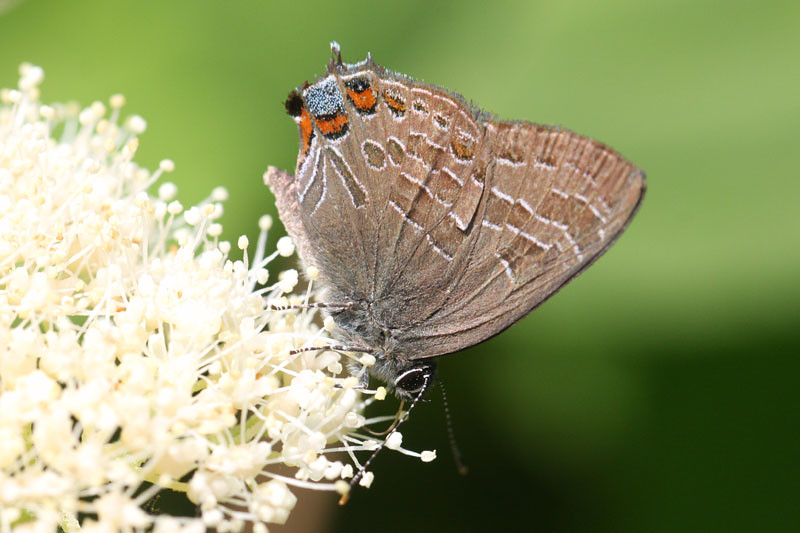Here in Kunkletown, I spent 12 hours looking for butterflies. I decided to spend the entire day butterflying around my property.
I started at 7:00am and within a few minutes, found the first butterfly of the day, a fairly large brown one called a Common Wood-Nymph. Throughout the day, I walked through the field and the woods, counting every species that I could find.
The biggest surprise came when I checked a blooming Wild Hydrangea. From a distance, I saw a small, dark butterfly nectaring on the flowers. When I got closer, I realized that it was a hairstreak. I assumed that this was a Banded Hairstreak, a fairly common butterfly of woodlands during the summer. However, when I put up my binoculars to get a better view, I realized that I was looking at a Striped Hairstreak. Striped Haristreaks are much less common than Bandeds, so this was a great treat.
Striped Hairstreak on Wild Hydrangea
Although a few butterflies, like the hairstreak, a Summer Azure, and some Northern Pearly-eyes were in the woods, the majority of the butterflies that I found were in the field. Blooming Common Milkweed and Canada Thistle attracted many butterflies including Great Spangled Fritillaries, very large numbers of Little Glassywings, and even a Common Buckeye.My final species of the day was a Crossline Skipper. On my final check of a large Common Milkweed patch, I found one of these with several Little Glassywings. Before I headed inside, I checked some Purple Coneflowers and found another Crossline.
I finished at 7:00pm with 22 species.
Here are the totals from the entire count:
1 Black Swallowtail (Papilio polyxenes)
3 Eastern Tiger Swallowtail (Papilio glaucus)
22 Spicebush Swallowtail (Papilio troilus)
89 Cabbage White (Pieris rapae)
16 Clouded Sulphur (Colias philodice)
7 Orange Sulphur (Colias eurytheme)
1 Striped Hairstreak (Satyrium liparops)
1 Gray Hairstreak (Strymon melinus)
5 Eastern Tailed-Blue (Cupido comyntas)
10 Summer Azure (Celastrina neglecta)
34 Great Spangled Fritillary (Speyeria cybele)
1 Common Buckeye (Junonia coenia)
6 Milbert's Tortoiseshell (Aglais milberti)
8 Red Admiral (Vanessa atalanta)
1 Hackberry Emperor (Asterocampa celtis)
2 Northern Pearly Eye (Enodia anthedon)
7 Little Wood Satyr (Megisto cymela)
5 Common Wood Nymph (Cercyonis pegala)
7 Silver-spotted Skipper (Epargyreus clarus)
1 Northern Cloudywing (Thorybes pylades)
15 Least Skipper (Ancyloxypha numitor)
51 European Skipper (Thymelicus lineola)
1 Tawny-edged Skipper (Polites themistocles)
2 Crossline Skipper (Polites origenes)
4 Northern Broken-Dash (Wallengrenia egeremet)
42 Little Glassywing (Pompeius verna)
2 Delaware Skipper (Anatrytone logan)
2 Hobomok Skipper (Poanes hobomok)
1 Dun Skipper (Euphyes vestris)
1 Common Roadside-Skipper (Amblyscirtes vialis)
Thank you to Arlene Koch and Dan Kunkle for being the counters in the other areas!



No comments:
Post a Comment